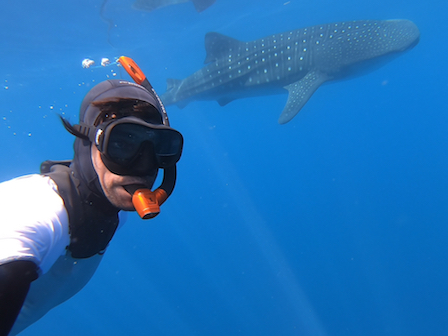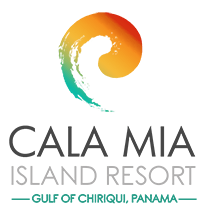Diving at Coiba Island
Cala Mia offers a fully equipped dive facility, so you can enjoy diving Coiba Panama. We are an environmentally friendly dive operation and have a “no touch” policy on all dives. The Chiriqui Marine National Park is home to dozens of pristine islands and unspoiled beaches, including Coiba Island, a world-renowned destination for diving.
The reefs of Coiba occupy more space than any other reef system in the Eastern Tropical Pacific. Some of the reefs around Coiba are more than 5,000 years old and the waters hold 760 species of fish, 33 species of sharks and rays, and over 20 species of marine mammals.
Diving Coiba Island, Panama
The Coiba Island is described as the “New Galapagos” and offers some of the best diving in Panama. On a single trip out from our Coiba dive resort, you can spot dolphins, humpback whales, manta rays, barracudas, whale sharks, hammerhead and tiger sharks, and much more. It is here that divers find a unique paradise of thriving coral reefs and multitudes of fish. Divers can get to see marine life that you can’t see in no other place on Earth.
Interactive Dive Map
Isla Coiba Dive Locations:
Dive Site: Frijoles Ridge, Coiba National Park – Coiba Island
Frijoles Ridge is boat dive located close to Coiba Island, travel time is 90 min from Cala Mia Island Dive Resort.
We can find a series of underwater mountains that start at a depth of 20ft/6m and descend to 150ft/45m. The depth range in this spot is 15ft/5m – 130ft/40m. The temperature is around 27-29 C/ 80-85 F. There is a mix of hard and soft corals, and exuberant sponges where Seahorses and Frog Fish inhabit. The presence of currents is great for drift diving.
This ridge features many rocky ledges that form a great natural environment for the White-tip shark, and the Cubera Snapper. In this location there are many spots where aquatic life such as Manta Rays, and the Giant Oceanic Manta congregate to be cleaned by smaller creatures.
Suitable for advanced divers
Dive Site: Octopus Rock, Coiba National Park – Coiba Island
Octopus Rock is boat dive located close to Coiba Island, travel time is 90 min from Cala Mia Island Dive Resort.
It is a small rocky islet, and during low tide its rocks are visible. After a shallow descent you can spot a garden of hard corals. The average depth is 15ft/5m – 130ft/40m. The temperature is around 27-29 C/ 80-85 F. There are many soft corals and marine sponges located in the transition zone after dropping in a moderate inclination in between the sand channel and a path of rocks. This site offers home for Frogfishes, Seahorses, Octopus, Eels, amongst other bottom dwellers. The fissures on the rocks provide shelter for many small living creatures.
Suitable for advanced divers
Dive Site: Twin Peaks, Coiba National Park – Coiba Island
Twin Peaks is boat dive located close to Coiba Island, travel time is 90 min from Cala Mia Island Dive Resort.
This site benefits from the protection of oceanic currents. There are two pinnacles that are separated by a sand channel and rise from a rocky layer of approximate 145ft/44m to 17ft/5m from the surface. Temperature is around 27-29 C/ 80-85 F. The concentration of marine life that inhabits these isolated pillar-like elevations is extremely high which makes this spot also a favorite. There is an outstanding variation of corals, and oceanic landforms. If you are looking to spot larger fishes, then this is the ideal spot as at a depth of 60ft/18m we can spot many White-tip sharks. And, most likely you will also see the Oceanic Manta Ray, and Whale Shark, amongst other amazing living creatures.
Suitable for intermediate to advanced divers
Dive Site: Jacobs Ladder, Coiba National Park – Coiba Island
Jacobs Ladder is boat dive located close to Coiba Island, travel time is 90 min from Cala Mia Island Dive Resort.
The pinnacle, covered in white gorgonians, is very close to the drop off the deepest waters of the Coiba National Park, which makes of this an exposed site to strong currents and swells. The shallowest point of this pinnacle requires a descent of 45ft/13m. Temperature is around 27-29 C/ 80-85 F. Surrounded by large rocks that can be found at 52ft/16m and followed by an unexpected fall to more than 131ft/40m. The Galapagos Shark, and Tiger Shark are seen regularly. You can also spot Eagle Ray, Manta Ray, Devil Ray, White-Tip sharks, Sea Turtles, Sailfish, Barracuda, Schools of Jacks, and Snappers.
Suitable for intermediate to advanced divers
Dive Site: Isla Iglesias, Coiba National Park – Coiba Island
Isla Iglesias is boat dive located close to Coiba Island travel time is 90 min from Cala Mia Island Dive Resort.
Protected from the currents, this site has extensive sandy areas where you can find pinnacles. Temperature is around 27-29 C/ 80-85 F. You could start at a shallow depth of 30ft/9m and descend to a deeper pinnacle of 120ft/35m. It is usual to spot schools of Rays, Spade Fish, and Big Eyed Jacks. This site is filled with soft corals and sponges, which provide home for Frog Fish, and Seahorses.
Suitable for intermediate to advanced divers
Dive Site: Picos Gemelos, Coiba National Park – Coiba Island
Picos Gemelos is boat dive located close to Coiba Island, travel time is __ min from Cala Mia Island Dive Resort.
These two rocks are mostly protected from the ocean currents. They emerge from a slope of sand that descends to 68ft/21m. In the walls of these rocks and the ones surrounding, you can spot an array of gorgonians, sponges, hard corals and sea fan which is another variety of coral. Species to be spotted are Seahorses, Barracuda, Jacks, Mantas, White-tip Shark, Whale Shark, Frogfishes, amongst others. Temperature is around 27-29 C/ 80-85 F.
Suitable for advanced divers
Dive Site: Buffet, Coiba National Park – Coiba Island
Buffet is boat dive located close to Coiba Island, travel time is 90 min from Cala Mia Island Dive Resort.
This site consists of a group of rocks. The reef begins at about 39ft/12m and extends to a depth of 91ft/28m. This diving spot is surrounded by rock formations where you can spot groups of sharks, Moray Eels, different types of Jacks and schools of Barracuda. It is exciting to spot White-Tip Sharks and types of Trevally hunting in some of these rocks. Whale Sharks, and Oceanic Manta Rays are seen often. Temperature is around 27-29 C/ 80-85 F.
Suitable for advanced divers
Dive Site: Wahoo Rock, Coiba National Park – Coiba Island
Wahoo Rock is boat dive located close to Coiba Island, travel time is __ min from Cala Mia Island Dive Resort.
This diving spot and the Buffet merge into one another. The tip of this rock sticks up from the surface which makes it easier to locate. There are shallow sandy areas, as well as deep and steep water cliff. It is very important to be on a constant check out of your surroundings as you could out of a sudden end up at 27 meters deep without even knowing. It is usual for plankton to accumulate in this area which becomes an attraction for big fishes. You can spot Sea Turtles, Reef fish, Moray Eels, amongst other reef fishes. Temperature is around 27-29 C/ 80-85 F.
Suitable for advanced divers
Dive Site: Bajo Piñon, Coiba National Park – Coiba Island
Bajo Piñon is boat dive located close to Coiba Island, travel time is 90 min from Cala Mia Island Dive Resort.
There are many ways of diving this reef due to the distribution of its rock formation. You can find an abundant existence of marine life in a depth range of 19ft/6m-72ft/22m. Spot schools of Big Eye Jacks, Barracudas, Moray Eels, Sea Turtles and even some sharks that relax on the sandy bottom. It is common to see Whale Sharks swimming by, as well as Bluefin Trevallys, and Mantas. Temperature is around 27-29 C/ 80-85 F.
Suitable for all levels of expertise
Dive Site: Faro, Coiba National Park – Coiba Island
Faro is boat dive located close to Coiba Island, travel time is 90 min from Cala Mia Island Dive Resort.
Located to the western tip of Isla del Canal de Afuera, the location is exposed to ocean currents. This site has a combination of shallow areas and a reef that can reach depths of approximate 98ft/30m. It is usual to spot schools of Big Eye Jacks, Barracudas, and groups of Cubera Snapper. Whale Sharks, and Manta Rays often visit this spot due to the accumulation of plankton which is favored by the currents. Seahorses, Octopus, Scorpionfish, and frogfishes can be spotted too. Temperature is around 27-29 C/ 80-85 F.
Suitable for advanced divers








